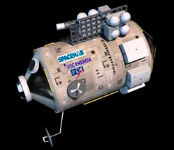Created: 2023-08-10
Updated: 2025-09-06
Company - Spacehab
- Founded
- Country
- 1984
- USA
- Funding
- Yes, ?
Product/Service - Enterprise
- Classification
- Space Stations & Habitats
- Category
- Commercial Space Station
Commercial ISS Module
Space Entertainment
- Fields
- Commercial ISS Module
- Status
- Cancelled
- First launch
- 2002
A Big Sale in 1990
Public in 1995
SPACEHAB, Energia to build commercial module for ISS
Posted: Dec. 10, 1999
"Enterprise is an historic project -- the first commercial real estate in orbit," said SPACEHAB President David Rossi. "This partnership is the first big step off Planet Earth for private enterprise in space, independent of government funding, " he said. "The ISS partners have endorsed greater commercial participation in the space station. As a private company with 15 years of experience working in manned space and partners and customers around the world, we are committed to making space commerce a reality."
SPACEHAB, with its Johnson Engineering and Astrotech subsidiaries, is the world's leading provider of commercial payload processing services for manned and unmanned payloads. The Company also supports NASA astronaut training at the Johnson Space Center.
Spacehab (Astronautix)
Status: Operational 1993. First Launch: 1993-06-21. Last Launch: 1999-05-27. Number: 14 . Gross mass: 5,000 kg (11,000 lb). Height: 3.00 m (9.80 ft). Span: 4.50 m (14.70 ft).
Spacehab, Energia Complete Basic Design Of ISS Commercial Module
Spacehab sets prices for its planned Enterprise ISS module
Staff October 09, 2000
PRICE LIST: Spacehab Inc. and RSC Energia have listed prices for their planned "Enterprise" commercial module on the Russian side of the International Space Station, giving microgravity researchers what could be a cheaper option for ISS facilities but charging more for getting their gear to the…
Enterprise ISS Module
The agreement was announced Dec. 10 at the National Press Club in Washington.
Extending the business
Spacehab’s current core business involves flying experiments and supplies in pressurized modules within the space shuttle’s cargo bay, and Harrison said the new venture would extend that line of business to the International Space Station.
NASA's role
One might well ask what role NASA has in all this. “There’s no direct involvement as far as NASA is concerned,” Harrison replied.
However, he said, the Enterprise plan was in line with NASA’s long-range goals.
Spacehab’s ‘Enterprise’ moves to Shuttle for lift, but customers remain elusive (SpaceRef, 2001-10-08)
MPM (Enterprise) - Gunter's Space Page
Due to lack of funds, the MPM Enterprise was cancelled. It was replaced by the MLM module.
Space Media
Entermedia
Status Comment
In 2007, there were 2 warnings from NASDAQ about deficiencies.
Space station module and related in-space products/services seem cancelled as of 2023.



























































